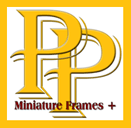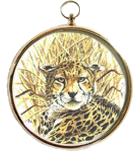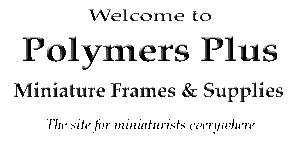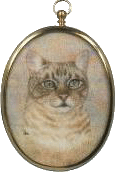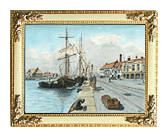Ivorine
Sadly Ivorine is no longer in production.
But below is a discription of the product for interest purposes only.
What is Ivorine: Ivorine, to a miniaturist, is a plastic sheet, 0.5mm thick translucent white in colour with a matt finish on both surfaces. It is normally supplied in sheets 7 ¾ x 5 ¼ inches under this name To date it has not been possible to determine if this was ever registered as a trade name. It could even be that the name has some horticultural origins, as there is a variety of the hardy herbaceous bush Aconitum or Monkshood which is known as Ivorine because of its ivory-white flowers.
In the general world of miniatures it is a name that has been accepted to describe the sheet material upon which some miniaturists paint their pictures, whereas in America it seems to be also used, sometimes spelt Ivorene, to describe any product made from Celluloid. The chemical name for it is Cellulose Nitrate it is also widely known as Celluloid. It has been given a number of trade names by those factories that produced it, the best known of which is Xylonite.
Historical Notes:Cellulose Nitrate was first accidentally discovered by a Swiss/German chemist in 1845 who having spilt some acid (nitric or sulphuric), wiped it up with his wife's apron, which it is assumed was cotton. He then put it near to the fire to dry and found that when it got to a certain temperature it burst into flames and was consumed in seconds. This information eventually came to the notice of Michael Parkes an English inventor who investigated this and found that by mixing cellulose (obtained from cotton or wood pulp) with nitric or sulphuric acid and other ingredients such as vegetable oils and organic solvents he could produce a dough which could be moulded with gentle heat and pressure into a variety of objects. He called this material Parkesine. This was the first Semi-synthetic thermoplastic raw material. Parkes was not a very successful businessman and in 1869 he signed over his patent rights to The Xylonite Company which was originally sited in Homerton in East London. But as the London suburbs became more densely populated, and as the production process was hazardous with a real risk of explosions, the main production plant was moved to Brantham near Manningtree on the Essex/Suffolk border on the river Stour this was convenient as the dangerous chemicals required could be transported and delivered by sailing barge (today there is still a Thames barge called Xylonite which frequently sails and wins barge sailing contests). The less hazardous conversion from raw material to finished product was carried out at Hale End (now Highams Park ) on the edge of Epping Forest Over the years the company changed its name to The British Xylonite Company Ltd. then BX Plastics Ltd. and finally the company was taken over by Wardle Storey plc. Who ceased the production of Xylonite in 1994. The Ivorine that is available today is made in Italy.
As Cellulose Nitrate was the first mouldable thermoplastic available to industry it was used for the manufacture of numerous products, it became more popular when it was found that the addition of camphor made it more flexible and less brittle. Amongst the many applications for which this material was used were brush backs, cutlery handles, combs, collars and cuffs, toothbrush handles, buttons, dice, spectacle frames, umbrella handles, early dental plates, billiard balls (It has been reported that in Victorian times 12000 elephants, ideally females who had smaller tusks of higher quality, were slaughtered to satisfy the needs of the UK only for billiard balls). And finally table tennis balls. Because of its explosive nature it also had a number of military applications as well as in the pyrotechnics industry. I think that it is safe to say that none of the above applications use Cellulose Nitrate today, as superior and cheaper plastic materials have been developed.
The Production Process: The production of Cellulose Nitrate is a complicated, dangerous and labour intensive process, which at many stages requires the use of highly skilled operators. It also involves periods where the semi finished product needs to be stored for a considerable time under controlled conditions to ensure that its properties meet the required standards. In some cases the production of a batch of Cellulose Nitrate could take months. The preferred source of cellulose was cotton linters, the short, fine fibres that surround the cotton seed, these were dissolved, filtered mixed with plasticiser (camphor which gives Ivorine its distinctive smell) it is then coloured if required (Cellulose Nitrate in its natural form is absolutely transparent) it is then compounded and pressed into blocks about 54 x 28 x 6 inches. It is then sliced into sheets of the required thickness and stored until the required properties are attained and then it is pressed, using heat and pressure, and perhaps laminated to ensure that the required thickness is achieved and at this stage that the surface finish is applied by using highly polished stainless steel for a gloss finish or shot blasted sheets for a matt finish. Because the production process is so complicated and the world requirement is so small it will not be surprising to learn that Cellulose Nitrate is one of the most expensive plastic raw or semi-finished materials.
Cellulose Nitrate and the Miniaturist: From now on let us refer to this material as Ivorine. I am not sure who was the first artist to use Ivorine as a base for miniatures, neither do I know when this happened. I think however that it would probably be around the beginning of the twentieth century. Miniaturists represent a small minority of artists be they professional or leisure painters, furthermore their requirements for supplies are also small with the result that we don't have the ‘clout' to demand from industry that they make any product for the sole use of miniaturists. The result is that many of the products that we use are also used elsewhere either in industry or by a larger number of artists who paint large pictures. Ivorine is a prime example of this, as the material that we know as Ivorine is identical to the plastic sheet that was used to make table tennis balls. To make these the plastic sheet was formed by heat and pressure (or vacuum) into a series of hemispheres. These were then stamped out and joined together to make a ball. This sheet, had the characteristics that were ideal for both table tennis balls and as a replacement for ivory which was both expensive and somewhat difficult to obtain. Ivorine has a number of properties, which make it a very good base for miniatures. It also has some shortcomings, which have been accepted over the years, whilst its flammability is a disadvantage it is not really a hazard to the artist or collector. One problem has occurred, the solution to which is in the hands of the producing factory, this relates to changes in the surface texture which causes changes in the tooth. This is because the shot-blasted steel sheets which produce the matt surface texture become smoother with repeated use. This has been described as an unfamiliar ‘slipperiness' which regrettably cannot be satisfactorily rectified except by the manufacturer. The main problem associated with Ivorine however is dimensional stability. If it is not correctly stored it will buckle. This is because it contracts as the camphor and other volatile constituents ‘evaporate'. This is not normally a problem if a picture is painted on flat Ivorine and then framed as the confined space with reduced air circulation reduces the speed of ‘evaporation'. Another problem encountered when using Ivorine (which is related to the tendency of some constituents to ‘evaporate') is the need to de-grease it before commencing painting because residues remain on the surface and impede the flow of the paint. This problem is normally solved by rubbing the surface with a talcum impregnated cotton wool pad. The surplus talc can be removed by simply dusting it off or it could be washed off by immersion in a weak solution of washing up liquid and warm water
The surface should be patted dry rather than vigorously rubbing it which could induce an electrostatic charge. To paint in watercolour on Ivorine or any other non-absorbent surface it is necessary to use a technique that is different from that used when painting on paper. The most important thing to remember is that the paint that you apply is resting on the slightly roughened surface of the Ivorine and that it is just as easy to remove it as it is to apply it. Therefore it is recommended that you use as dry a brush as possible and apply the paint with either hatching or stippling strokes. This will result in insufficient colour being applied so it is necessary to apply additional coats of paint to build up sufficient depth of colour. It is imperative that additional coats must not be applied until the under coats have dried completely.
